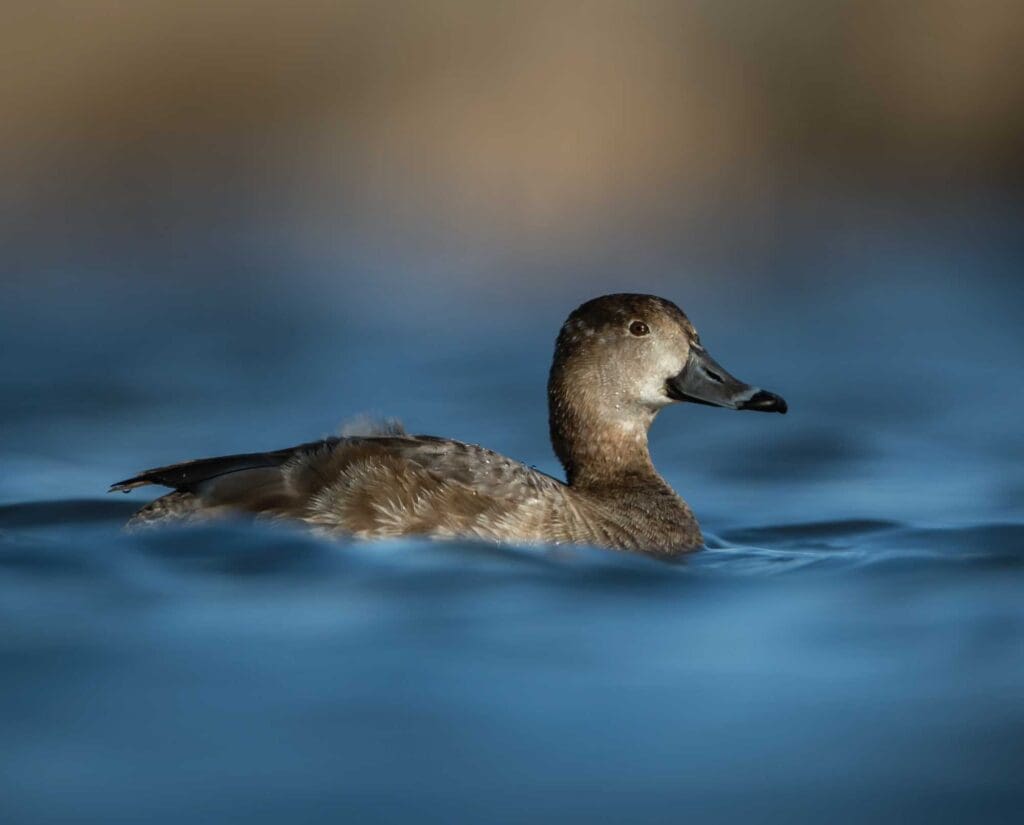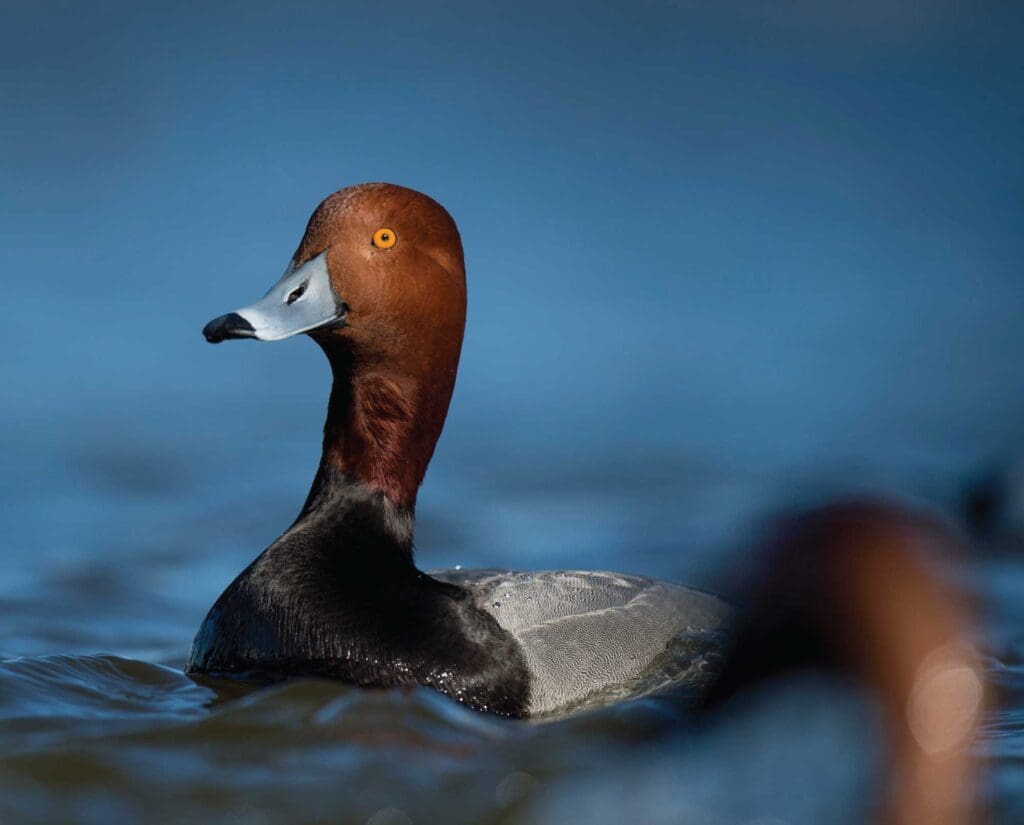Home » Waterfowl Hunting » Redhead Duck (Aythya americana)- Waterfowl Species Profile
Redhead Duck (Aythya americana)- Waterfowl Species Profile

Ryan Lisson is a biologist and regular content contributor to…
Learn about the redhead diving duck life history, biology, habitat, conservation issues, and more.
The redhead duck (Aythya americana) is a striking member of the diving duck group. While the drakes stand out for their looks, hens stand out for their nesting preferences, laying eggs in nests of up to 10 different species of ducks and other birds too. Redheads are very social, and can be seen in wintering flocks that number in the tens of thousands on southern coastal waters.
Description and Life History of the Redhead
The redhead usually measures about 18 to 20 inches long and weighs approximately 2 to 3 pounds (NatureServe 2020). Drakes in full breeding plumage are bold with cinnamon/red-colored heads and necks, bright yellow eyes, dark gray or black breasts and rear ends, and finely mottled gray sides. Their rounded heads sport a pale blue/gray, black-tipped bill. Hens have uniform light brown feathers with a pale blonde face, dark eyes with a ring of cream-colored feathers surrounding them, and a similar bill as males. While flying, a gray-colored speculum (wing stripe) extends from the body out to the primary feathers on the wing tip (All About Birds 2020). Non-breeding males in eclipse plumage are more uniformly brown like hens, but their heads are still cinnamon-brown and their eyes are still yellow.
Breeding often begins in April (in the southern part of their breeding range) and may continue until June (in northern regions) (NatureServe 2020). Drakes perform an interesting courtship ritual, often bending their neck fully back so their heads touch their tails, and then snapping them forward while making a cat-like call (All About Birds 2020). Hens build nests within dense vegetation (usually bulrushes or cattails) in shallow marshes, and line them with down from their bodies (National Audubon Society 2020). Redheads are notorious for laying eggs in other bird’s nests – a practice called brood parasitism. In addition to laying them in other redhead nests, they have been known to lay their eggs in up to 10 other duck species (including canvasbacks) and even non-duck species (National Audubon Society 2020). Hens usually lay 7 to 14 cream- or buff-colored eggs and incubate them for 22 to 29 days (All About Birds 2020; National Audubon Society 2020). However, they may also lay several additional eggs in the nests of other species. The ducklings usually are fully fledged by 10 to 12 weeks of age (NatureServe 2020).

Unlike many other diving ducks, redheads more often feed by dipping their head underwater or tipping up to feed on plants and invertebrates (NatureServe 2020). During the winter, they often feed on plant seeds, rhizomes/tubers, and leaves of shoalgrass, pondweeds, wild celery, bulrushes, water lilies, and wild rice (Ducks Unlimited 2020; All About Birds 2020). But during the breeding season, females and young often eat more invertebrates, including snails, clams, mussels, caddisflies, midges, and mayflies (All About Birds 2020).
While nest sites built in dense emergent marshes are often protected from most mammalian predators, there are still some threats. Common predators of eggs and ducklings include mink, raccoons, crows, gulls, snapping turtles, and northern pike.
Range and Habitat of the Redhead
In North America, breeding redheads are a common inhabitant of the prairie pothole region, but they also occur in the Intermountain West area and even up to Alaska and northern Canada. They typically start migrating northward to breeding areas by May. They can spend their winters in the southern half of the U.S., but approximately 80 percent of the North American population is thought to winter in the Laguna Madre of Texas and Mexico along the Gulf Coast (Ducks Unlimited 2020).
The redhead spends its summer breeding season mostly in freshwater marshes, although it will also utilize lakes, rivers, reservoirs, ponds, and bays (NatureServe 2020; All About Birds 2020). During migration, many individuals gather in large lakes (including the Great Lakes) and reservoirs. During the winter, they form spectacularly large flocks in saltwater bays, lagoons, and coastal estuaries. Importantly, redheads make daily trips to freshwater inland wetlands to drink and reduce the high saline levels ingested while consuming shoalgrass in coastal waters (NatureServe 2020; All About Birds 2020).

Conservation Issues for the Redhead
The redhead is listed as globally secure and of Least Concern by the IUCN Red List (NatureServe 2020). The North American population was estimated at about 1.2 million birds as of 2015 (All About Birds 2020). As with most waterfowl species, loss or degradation of habitat due to human development, agriculture, and drought have all had a serious effect on the redhead. While programs to reverse that trend have been successful, it will likely always continue to be a threat. A reduction in shoalgrass beds in overwintering areas is also a concern. It is estimated that hunters harvested about 300,000 birds annually in 2013 and 2014, which is relatively small compared to the population size (All About Birds 2020). Other threats to the redhead include disturbance of nesting and wintering sites by humans and collisions with power lines and buildings (All About Birds 2020).
Hunting Opportunities for the Redhead
Intentionally hunting redheads can be interesting for those not used to it. Although they are fast fliers and can be intimidating to shoot at, they decoy very easily due to their natural flocking tendencies. One of the best spots in the country to hunt redheads is, perhaps not surprisingly, along the Laguna Madre in Texas – this offers one of the best opportunities simply because it attracts so many birds. Hunting in this area at the right time can also produce wigeon or blue-winged teal for a nice mixed-bag hunt.
Equipment and Bag Limits
You need all of the normal duck hunting gear to hunt redheads. Such staples include a hunting license/federal duck stamp, a shotgun (12-gauge is the gold standard), non-toxic shotgun shells, waterfowl camouflage clothing (lightweight if hunting in Texas), a blind or layout boat, and numerous decoys. Since redheads are so gregarious, large decoy spreads work well to attract flocks. However, a smaller number of decoys can work in the right conditions and you do not need redhead decoys exclusively to attract them. The current daily bag limit for redheads is two birds.
Redhead Duck Hunting Techniques
You can hunt redheads from coastal shorelines, along freshwater ponds and lakes, or in open water settings from a boat. As mentioned earlier, larger decoy spreads have a better chance of attracting flocks. You can use similar decoy tactics as that of the greater scaup by using gang rig clips on your main line to form what looks like a large raft of ducks – that way, you can quickly set up in the morning. You may also consider running one long line of decoys downwind of your blind location, which can guide the ducks into your landing zone. As usual, try to keep your landing zone open to suit your shooting preferences – in front if hunting from shore, on the left if you’re right-handed and in the water, etc.
Because redheads often decoy easily, there is not as much of a need for calling. But you can entice spooky birds a little more in two ways: you can make a “brrr” sound into a standard mallard call or use a call made specifically to imitate diving ducks. With a little practice, you should be able to replicate these sounds and call some birds in.
Ryan Lisson is a biologist and regular content contributor to several outdoor manufacturers, hunting shows, publications, and blogs. He is an avid small game, turkey, and whitetail hunter from northern Minnesota and loves managing habitat almost as much as hunting. Ryan is also passionate about helping other adults experience the outdoors for their first time, which spurred him to launch Zero to Hunt, a website devoted to mentoring new hunters.



